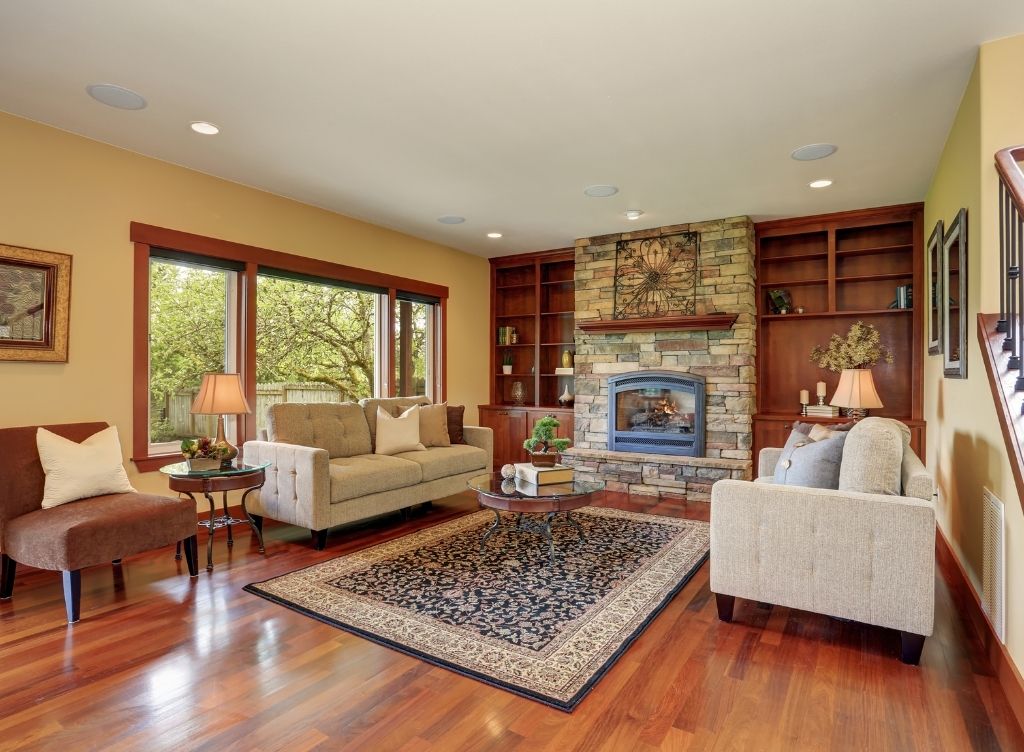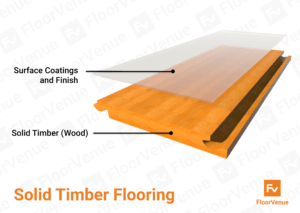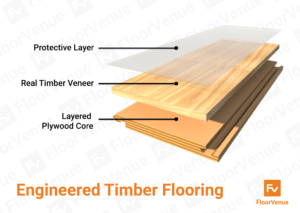

16 Aug Living Room Flooring Ideas
Selecting flooring for any room in your home involves careful consideration of the overall house’s style. This becomes even more obvious in the living room, which is usually a central room in the home. Living rooms – a high traffic space in a house, are where family and friends gather to spend time together, relax, socialise and entertain at the end of the day. Thus, by taking the title as ‘social hub of the home’, the living room requires big investment to certainly work hard for its appellation.
This article will break down the top living room flooring ideas, with an eye for design and functionality in mind.
Natural Wood Flooring Ideas
Real wood flooring options have historically been in high demand, constantly appreciating in value and beauty over time. Even though this is an expensive option, you are guaranteed to make your investment worthwhile thanks to the longevity and unparalleled visuals they bring.
The upfront costs of installation and purchase of materials are balanced by the longevity and endurance you receive, especially when you have children and pets actively travelling around the home that causes heavy traffic in areas like the living room. This is because real timber can be sanded and polished multiple times every decade or so – removing accumulated scratches and scuffs for a brand new look.
I’ll arm you with three types of natural flooring you need to consider to choose the best and most suitable floor for your living room and more.
- Solid Timber Flooring
- Engineered Hardwood Flooring
- Engineered Oak Flooring
Solid Timber Flooring
Solid timber refers to planks cut straight from trees, usually 18 – 21mm thick in solid natural wood floors. Not only are they the most expensive and premium option, but solid timber offers the unparalleled beauty of natural hardwood which synthetic options cannot match. Note that there are two types of solid hardwood flooring.


Pre-Finished vs Raw Timber
- Pre-finished solid timber – refers to planks which have been sanded and polished in the factory, meaning they can be walked upon immediately after installation without further preparation. This is more commonly bought than raw timber.
- Raw solid timber – selected for its customisation capability, as it allows for sanding, staining for a specific colour, and then polishing with a coating of your choice. At a similar material price, the overall cost including labor tends to be slightly higher for raw hardwoods.
PROS
- Solid timber is considered the most premium flooring option, and in fact garners the highest housing resale value out of all flooring types.
- Solid timber can be sanded and polished multiple times, allowing them to last a lifetime with proper care and maintenance.
- Hardwood planks have natural water resistance and can be installed in the kitchen.
- Hardwood flooring can age beautifully over time, as the tannin material makes them become richer in tones.
CONS
- Solid timber is prestigious, but it is also expensive to purchase, and difficult (thus costly) to install as you need nails and glue.
- These planks tend to age well, however some prefer the original look as it does darken over time. This feature may not bode well with those who enjoy a lighter tone.
- Although they are naturally water resistant, that doesn’t equate to full waterproofing. You will still need to wipe away spills and avoid flooding the floors when mopping.
Want to browse real solid timber planks? You may view the timber flooring colours, or check out our Guide to Choosing a Timber Floor Species.
Engineered Hardwood Flooring
Engineered hardwood flooring is the second closest thing you can get to natural, solid hardwood. This engineered wood has a real hardwood veneer (0.6 – 4mm) layer on top of man-made materials like plywood or composite core-boards.
Hardwoods which are primarily sourced from Australia are famous for their beautiful and warm colours. Without extra finishing and refinishing required, engineered wood is extremely durable, out-of-box ready and offers looks in just about every trending wood look.


PROS
- Super easy to install yourself
- More affordable than solid timber
- Can be sanded and polished for a complete facelift if scratches catch up with time
- It’s designed and created to counter the downfall of its natural counterpart, especially for rooms which are high on moisture
- It’s environmentally friendly since they use less wood than solid timber
CONS
- If plywood is used in the core layers rather than composite material, they could be damaged by water with prolonged exposure
- Engineered hardwoods are susceptible to dents and pet scratches
- Susceptible to ageing with prolonged exposure to sunlight (could be a benefit as it ages gracefully)
- Cannot be sanded and polished as much as solid timber since the surface veneer is thinner
Engineered Oak Timber Flooring
Engineered oak flooring consists of a layer of European oak timber (different to hardwood) attached to a plywood or waterproof composite core. It is a great alternative living room floor to solid or engineered hardwood as the two ranges offer vastly different visual designs.
It is favoured by designers for aesthetic appeal and by industry trade for the ease of installation and breadth of application. This flooring option creates the perfect talking point in both commercial and residential spaces.
PROS
- Being made entirely of real timber, the appearance and texture have authentic look
- Have greater stability in high-humidity environments
- You may save installation costs due to the locking mechanism of floating floorboards
- Engineered timber is more sustainable and environmentally friendly
CONS
- Despite of being more cost-effective than solid hardwood, your savings may vary and engineered timber is more expensive than vinyl flooring option and laminate alternative
- Engineered oak flooring made from plywood core-boards are prone to water damage, as opposed to composite core alternatives.
Synthetic Flooring – Laminate & Hybrid
Synthetic flooring is the use of flooring materials that are industrially made to meet different consumer tastes and preferences; for example, hybrid flooring, luxury vinyl planks and laminate floors. Currently, people prefer synthetics as the best affordable flooring option for their living spaces.
When you have kids and pets who simply have too much energy, sometimes it is worth it to invest in a synthetic floor covering rather than natural timber. This comes with benefits including greater moisture resistance (or even full waterproofing), durability, and is lighter on the budget!
Laminate Flooring
Laminate floors consist of a durable print layer glued to a strong particleboard. Laminate floors are sometimes called laminate wood floors, since the particleboard is made of high density recycled wood fibres.
Laminate flooring is a popular type of floor covering for homes’ space such as living room, kitchens, dining areas, bedrooms, hallways, and other areas that are not subject to excessive moisture.
Laminate floors hold their place as an inexpensive and functional flooring. They look, perform and feel better underfoot than ever before.
PROS
- Easy to clean
- Very Scratch-resistant
- Affordable and simple to install
- Can be waterproof in higher end ranges
- Little natural variation and high colour maintenance overtime
- Inexpensive price compared to other flooring ideas
CONS
- Can lack the natural feel of timber amongst cheaper versions
- Moisture can swell the laminate floor base in cheaper versions
- Chips easily in lower quality options
- Not suitable for highly wet areas such as bathrooms and laundry rooms
Hybrid Flooring
Hybrid is an innovative and latest room flooring type, combining the best characteristics of both laminate and vinyl to create an improved floating floor that can be installed throughout the entire home. Hybrid planks are made of multiple layers of materials pressed together for an extremely hard wearing floor and come in various designs and styles.
There are two main types of hybrid floors:
- Stone Plastic Composite (SPC): the core of the floorboards are comprised of limestone, polyvinyl chloride and stabilizers. More affordable and more durable than WPC hybrid floors.
- Wood Plastic Composite (WPC): the core of the floorboards are comprised of recycled wood and plastic. More comfortable underfoot compared to SPC hybrid floors.
PROS
- Minimal maintenance required
- More hardwearing than natural wood flooring
- Easy to install
- 100% waterproof
- Stain resistant – great as living room flooring!
- Most ranges come with pre-attached acoustic underlay
CONS
- Lack of authenticity of timber floors due to their plastic composition, especially in lower ranges
- May feel less solid underfoot if the subfloor is uneven
- Though hybrid floors are UV and fade-resistant, they can discolor with prolonged exposure to raw sunlight
Living Room Interior Designs
Modern
Living room is the place where we gather, laugh and play. These modern living rooms show stretch in a variety of substrates and styles. Centre modern furniture around a cubic rug. Forge a concrete paradise with living walls astride couches. Go futuristic, with colorful clocks that shine metallic. Design your lounge creatively, using these modern living room ideas as examples.
Contemporary
Contemporary interiors are often thought of as being ultra minimal with an abundance of razor-sharp lines, graphic prints and high-shine materials and surfaces. It’s talked of as being dynamic and daring. It’s praised for pushing boundaries and its mastery of light and reflection.
Contemporary design is about innovation and change that presents us with something fresh, different and disruptive.
Conclusion – Which Living Room Floor Is Best?
Living room is a high traffic area of your home and what you need to do is to choose the flooring which is not only beautiful, suits your home’s style but is also long lasting.
Choosing flooring for the living room is a big investment. The best living room flooring will make your space look great, feel cozy and prove easy to care for.
I’ll leave it to you, initiate the best living room flooring ideas for yourself. In the end, it really depends on your individual circumstance to determine what fits your style the most.




























